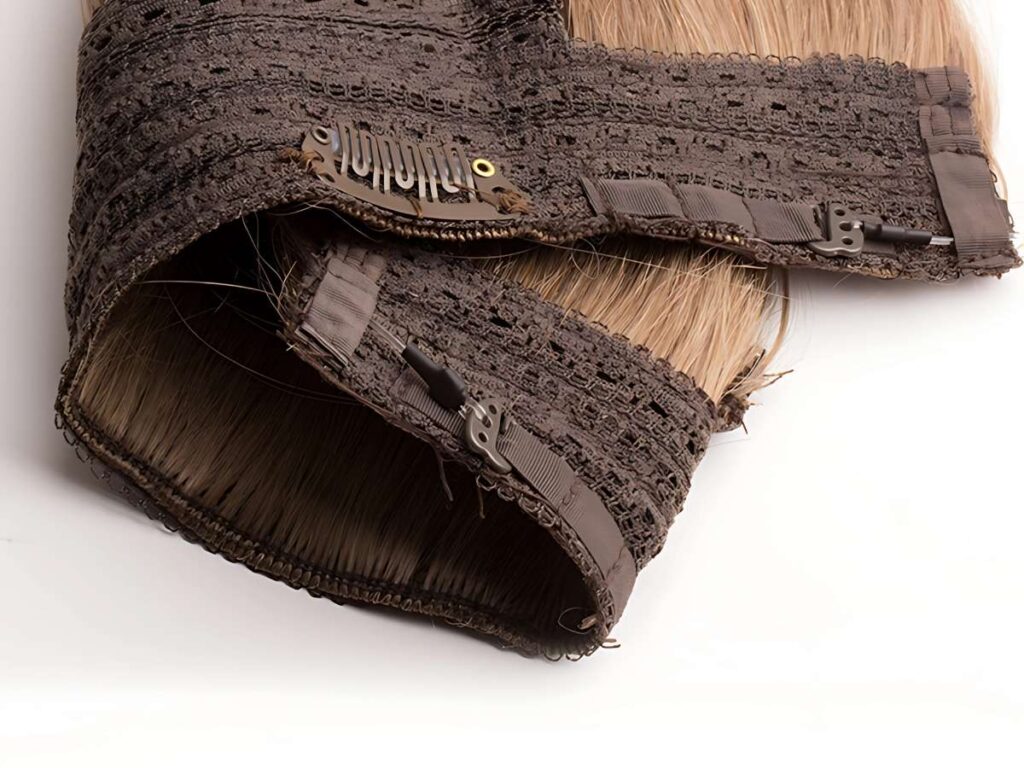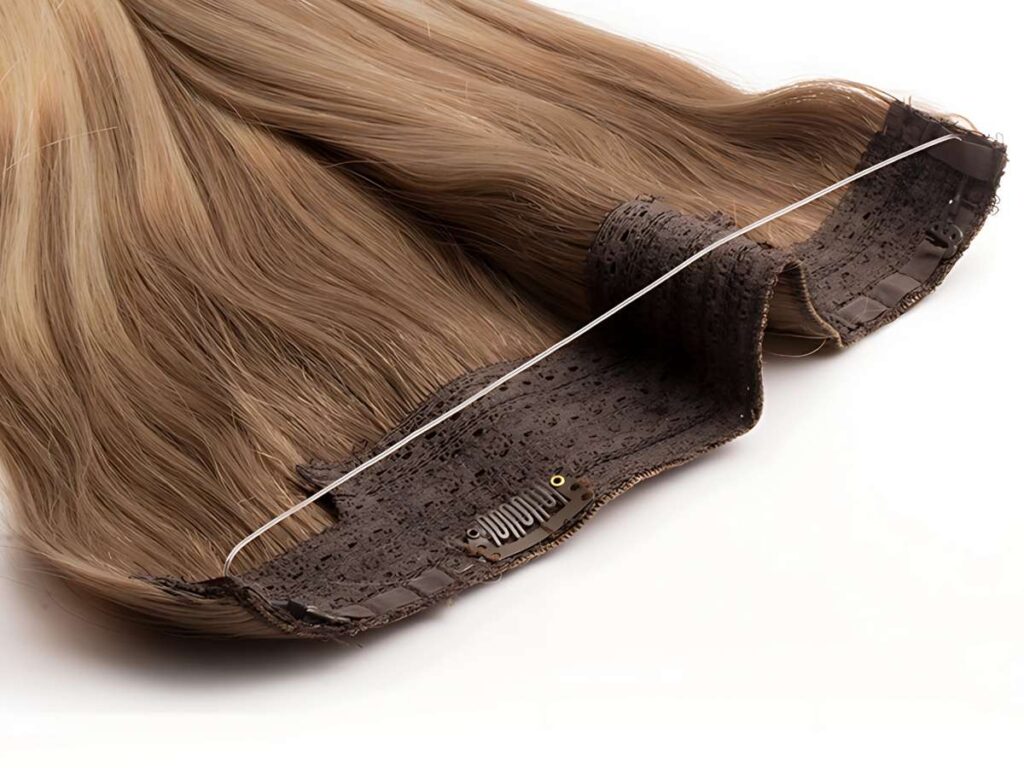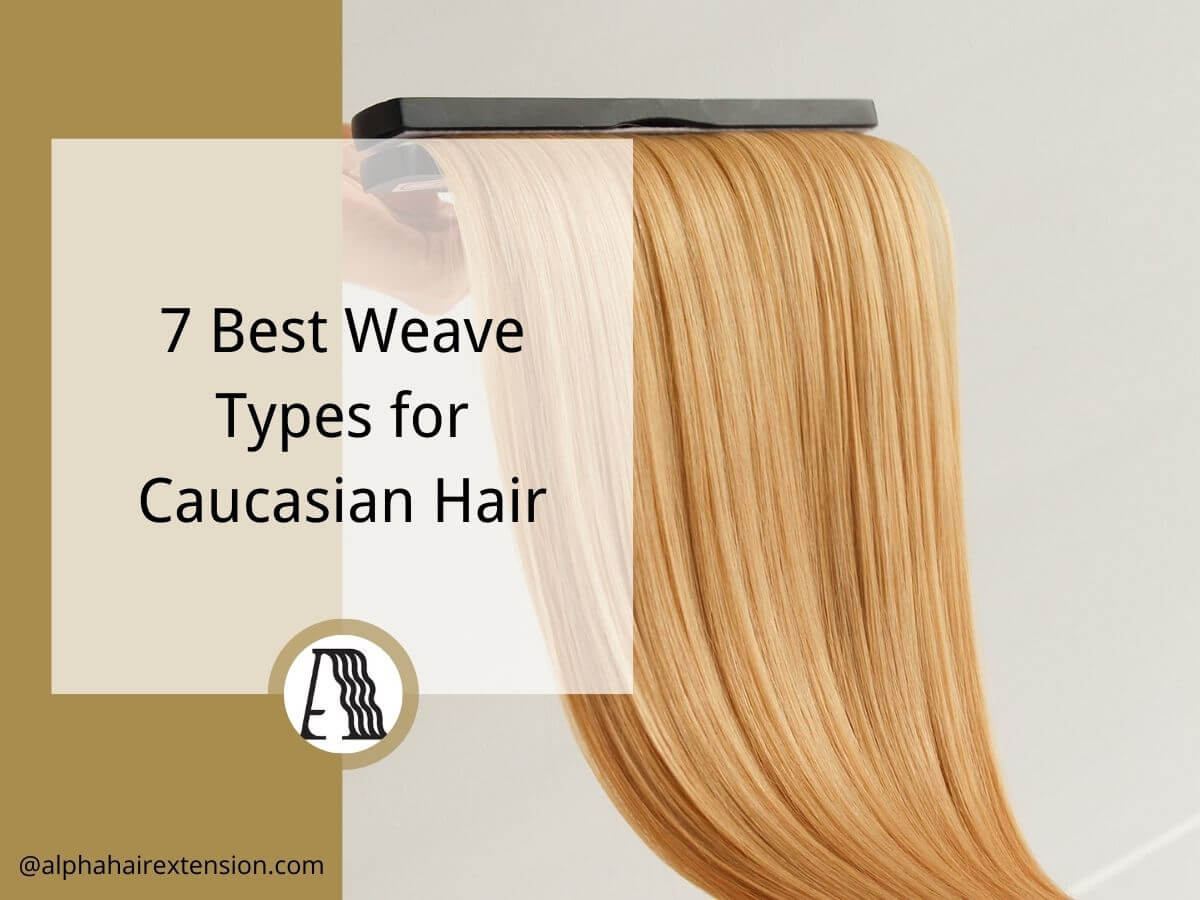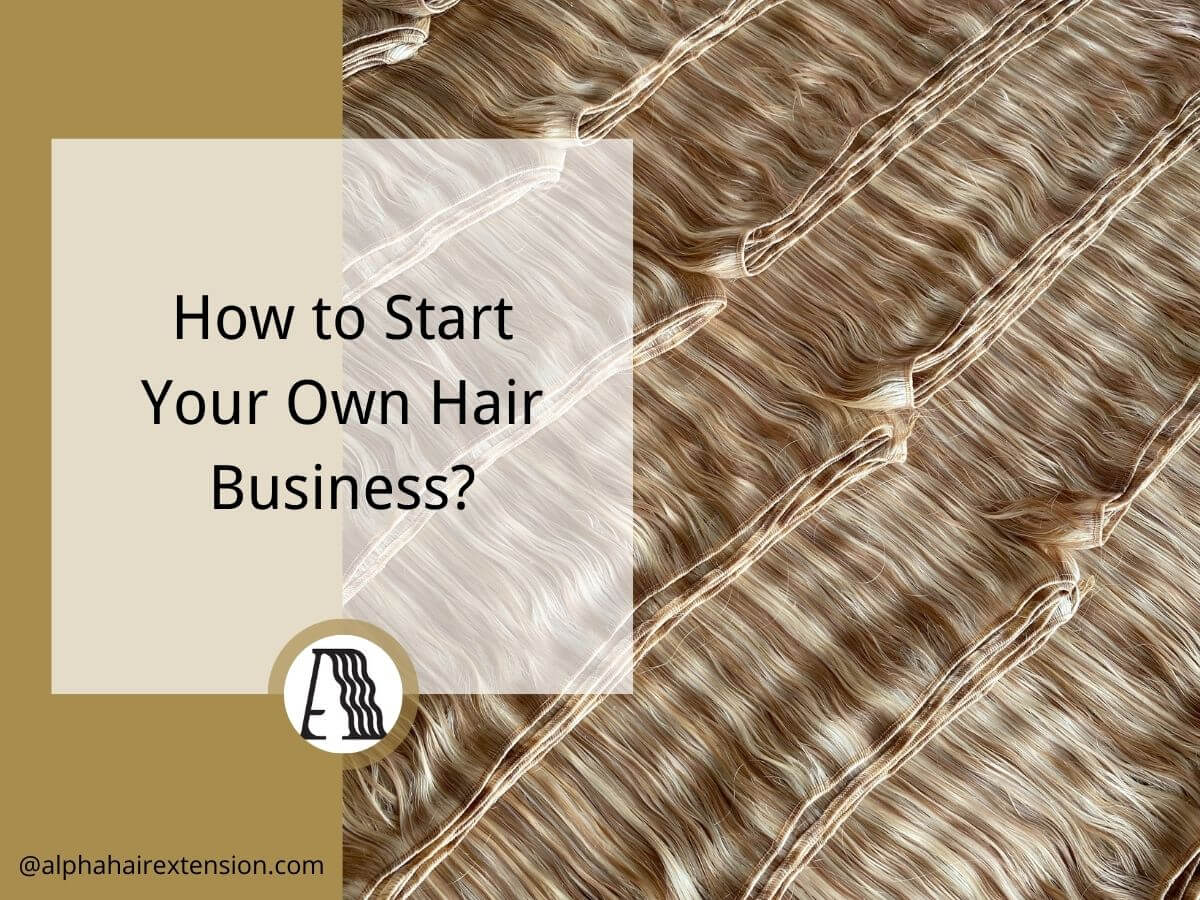I was at a trade show, watching a live demo of halo hair extensions. The model sat in the chair, and within seconds, the stylist placed the extension on her head. One simple adjustment, a little blending, and that was it. No clips. No glue. No mess.
I leaned in. That’s it?
If you’re searching for a way to offer customers a simple, mess-free option, you’re in the right place.
In this article, I’ll break down exactly how halo hair extensions work, how they’re applied, how they stay in place, and why they’re a smart choice for businesses.
Let’s get started.
1. What Are Halo Hair Extensions?
Halo hair extensions are a simple way to add length and volume without clips, glue, or tape. Instead, they use a thin, invisible wire that rests on the head, like a halo. The extension sits under the top layer of your natural hair, blending in seamlessly.
I remember the first time I saw one in action. I expected a complicated process—sections, tools, maybe even some adhesive. Instead, the stylist lifted a section of hair, placed the extension, and let the natural hair fall over it. That was it. No tugging. No stress. Just instant, fuller hair.
Why Are They So Popular?
More and more businesses are adding halo extensions to their product lines. Here’s why:
- Fast Application – They take seconds to put them on. No professional help needed.
- No Damage – Since they don’t attach to the hair, there’s no pulling, breakage, or residue.
- Comfortable – Lightweight and secure, they stay in place without tight clips or sticky glue.
- Reusable – Customers can take them off and put them back on as often as they like.
People want hair extensions that fit into their daily lives. They don’t want to spend hours in front of a mirror. They want something easy. That’s why halo extensions are growing in demand. They offer a quick, damage-free solution—something every salon, retailer, and distributor should consider.

2. How Do Halo Hair Extensions Work?
Halo hair extensions use a simple but effective design. Unlike clip-ins, they don’t attach to your hair. Instead, they sit on your head like a halo, held in place by a thin, invisible wire.
The “Halo” Design
The extension is one continuous weft of hair. It forms a loop, with the wire at the top and the hair hanging down. The wire sits around the crown of the head, resting comfortably without pulling or pinching.
I remember the first time I tried one. I expected it to feel loose or unstable. But once I placed it correctly, it stayed in place—even when I moved my head. That’s the beauty of the design. It’s secure, but you barely feel it.
The Role of the Invisible Wire
The wire is what makes halo extensions different. It’s clear, thin, and flexible. When placed correctly, it disappears under the top layer of hair.
- No glue
- No clips
- No damage
It works by using the natural shape of the head. The weight of the extension keeps it in place, while the wire holds everything together.
How the Extensions Blend with Natural Hair
Once the halo is on, the natural hair is brushed over it. This hides the wire and blends the extension with real hair. A few styling tricks, like curling or layering, can make the blend even smoother.
The result? More volume. More length. No complicated steps. Just natural-looking hair in minutes.

3. Benefits of Using Halo Hair Extensions
Halo hair extensions are changing the way people think about hairpieces. They offer length and volume without the struggles that come with clips, glue, or tape. Whether you’re a salon owner, retailer, or distributor, knowing their advantages can help you meet customer needs.
Quick and Easy Application
Traditional extensions take time. Clips need precise placement. Glue takes effort to remove. Tape requires professional help.
Halo extensions are different. They can be applied in less than a minute:
- Place the wire around the crown of the head.
- Adjust the fit so it feels secure.
- Let natural hair fall over the extension.
- Blend with a brush or light styling.
That’s it. No complicated steps. No long appointment times.
No Damage to Natural Hair
Hair health matters. Many people avoid extensions because they worry about breakage or hair loss.
Halo extensions don’t pull or stick to natural hair. The invisible wire holds the extension in place without applying pressure. Since there’s no glue, tape, or metal clips, there’s no risk of:
- Hair thinning
- Weakened roots
- Sticky residue
- Breakage from tugging
I’ve seen customers switch to halos after dealing with damaged hair from other methods. The difference was clear. Their natural hair stayed healthy, and they still got the volume they wanted.
Ideal for Beginners
Not everyone has experience with extensions. Some customers struggle with clips. Others avoid glue because it’s messy. Many just want something easy.
Halo extensions are a perfect solution for beginners because:
- They don’t require special skills.
- They stay secure without professional help.
- They can be removed in seconds.
A first-time user can wear a halo without frustration. That’s why they’re popular with everyday consumers, not just professionals.
For businesses, offering an easy-to-use product means more satisfied customers. More repeat buyers. More word-of-mouth recommendations.
4. Who Can Use Halo Hair Extensions?
Halo hair extensions are a great choice for many people. They’re simple, comfortable, and work for different hair types and lifestyles. But they’re not for everyone. Let’s break down who benefits most from them:
Best for Certain Hair Types & Lifestyles
Some people need extensions every day. Others just want them for special occasions. Halo extensions work best for those who:
- Want a quick, temporary solution.
- Prefer easy, no-fuss styling.
- Need volume or length for an event.
- Don’t want the commitment of permanent extensions.
Ideal for Those Who Want Temporary Length and Volume
Not everyone wants long hair all the time. Some just want it for a night out, a wedding, or a photoshoot.
Halo extensions offer that flexibility. They add instant length and fullness but can be removed in seconds. No long-term commitment. No salon visits. Just an easy way to switch up a look.
Suitable for Thin to Medium-Thick Hair
Halo extensions blend best with thin to medium-thick hair. They sit under the top layer, so the natural hair needs to be able to cover them.
For people with very thick hair, blending can be tricky. The extension may not sit as naturally, making it more noticeable.
Perfect for Beginners or Low-Maintenance Users
Some people struggle with clip-ins. Others don’t want the damage from glue or tape. Halo extensions are perfect for:
- First-time extension users.
- People who want a quick and easy option.
- Those who prefer a lightweight feel.
I’ve seen people hesitate before trying a halo extension. But once they see how simple it is, they never go back to other types.
5. Step-by-Step Application Process
One of the biggest advantages of halo hair extensions is how easy they are to use. No salon visit needed. No complicated steps. Just a few minutes, and you’re ready to go. Below is the step by step process:
Step#1: Place the Wire on the Crown
- Hold the halo extension by wire.
- Position it on the crown of the head, like a headband.
- The extension should sit below the occipital bone (the curved area at the back of the head).
At first, it may feel different. But once placed correctly, it stays put without discomfort.
Step#2: Adjust for Comfort and Security
- Gently pull the wire so it sits snug but not tight.
- The weft should lay flat against the back of the head.
- Make sure it doesn’t feel too loose or too tight.
The key is finding the right balance—secure enough to stay in place but comfortable enough to wear all day.
Step#3: Hide the Wire with Natural Hair
- Use a comb or fingers to pull sections of natural hair over the wire.
- The goal is to completely cover the top of the extension.
- Make sure the hair is evenly spread to avoid gaps.
Once the wire disappears, the extension starts blending.
Step#4: Blend for a Seamless Look
- Use a brush to smooth everything together.
- Lightly curl or style if needed to help the hair mix naturally.
- Check from different angles to make sure the blend looks natural.
That’s it. No clips, glue, or tape—just an easy, damage-free way to get longer, fuller hair in minutes.
6. Halo Hair Extensions vs Other Extension Types
Different hair extensions offer different benefits. Some require professional help, while others can be applied at home. The table below compares halo hair extensions with other popular types.
| Extension Type | Application | Time Required | Maintenance | Hair Health | Best For |
| Halo Extensions | Single piece, placed on the crown with an invisible wire. | Less than a minute. | Low—remove and store after use. | No damage, no pulling on natural hair. | Beginners, those who want temporary length and volume. |
| Clip-In Extensions | Multiple pieces clipped into different sections of hair. | 10-20 minutes. | Medium—must be removed daily. | Can cause breakage if worn too often. | Users comfortable with styling and sectioning hair. |
| Tape-In Extensions | Pre-taped wefts attached to natural hair by a stylist. | 30-60 minutes (requires salon visit). | Medium—lasts 4-6 weeks but needs reapplication. | May cause buildup or pulling if not applied properly. | Those looking for semi-permanent length and volume. |
| Fusion & Micro Links | Individual strands fused or linked to natural hair. | Several hours (requires professional application). | High—needs regular salon maintenance. | Can cause breakage or thinning over time. | People wanting long-term extensions with a natural look. |
For businesses, offering halo extensions means giving customers a flexible, beginner-friendly option. They’re a great alternative for those who want fuller hair without the hassle.
7. Care & Maintenance for Halo Hair Extensions
Taking care of halo hair extensions keeps them looking fresh and lasting longer. Proper washing, styling, and storage make all the difference. Here’s how to keep them in top shape.
Washing Guidelines
Halo extensions don’t need frequent washing. Since they don’t touch the scalp, they don’t absorb natural oils like real hair. Washing too often can dry them out.
Here’s the best way to wash them:
- Wash only every 10-15 wears or when there’s product buildup.
- Use sulfate-free shampoo and conditioner to prevent drying.
- Always using cool or lukewarm water—hot water can weaken the hair fibers.
- Gently massage the shampoo without rubbing or twisting.
- Rinse thoroughly and apply conditioner, focusing on the ends.
After washing, never wring out the water. I used to do this until I realized it caused frizz and breakage. Now, I just pat dry with a towel and let them air-dry flat.
Styling Tips
Halo extensions can be curled, straightened, or styled like natural hair, but care is key.
- Always use a heat protectant spray before using hot tools.
- Keep heat below 350°F (175°C) for human hair extensions.
- If using synthetic hair, check if it’s heat-friendly—many can’t handle heat.
- Brush gently before and after styling to prevent tangles.
A trick I always use? Style them before putting them on. It makes blending easier and prevents unnecessary tugging.
Storage & Longevity
Proper storage keeps halo extensions smooth and tangle-free. Leaving them out can lead to knots, dust buildup, or even damage.
- Store in a cool, dry place away from direct sunlight.
- Use a hanger or silk bag to keep them in shape.
- If storing in a drawer, make sure they’re detangled and loosely wrapped.
A little care goes a long way. With proper maintenance, halo extensions can last 6 months to a year—sometimes even longer. Taking a few extra minutes to store them properly makes all the difference.
8. How to Choose the Right Halo Hair Extensions for Your Business
Adding halo hair extensions to your business can be a smart move. But choosing the right products takes careful thought. From quality to color options, every detail matters. Here’s what to consider.
#1 Assessing Your Business Needs
Before placing an order, ask yourself:
- Who are your main customers?
- Do they want budget-friendly options or premium quality?
- Are they looking for daily wear extensions or occasional use?
Understanding what your customers need will help you stock the right products.
#2 Volume and Length Preferences
Different clients want different looks. Some want subtle volume. Others want long, dramatic hair.
- Shorter lengths (14-18 inches) work well for natural-looking volume.
- Longer lengths (20-24 inches) are ideal for dramatic transformations.
- Thick extensions blend best for fuller styles, while lighter densities work for fine hair.
Knowing these preferences helps you invest in the right inventory.
#3 Material and Quality
Choosing between human hair and synthetic hair depends on your market.
- Synthetic Hair – More affordable but less natural-looking. Limited styling options.
- Human Hair – Blends better with natural hair, lasts longer, and can be styled with heat.
I always recommend 100% Remy human hair. The cuticles stay intact, preventing tangling. Non-Remy extensions look great at first, but after a few washes, they turn into a mess. If you want happy customers, invest in quality.
#4 Choosing the Right Vendors and Suppliers
Not all suppliers provide consistent quality. Research is key.
- Request samples before making large purchases.
- Check for consistency in hair texture, thickness, and durability.
- Look for vendors that offer reliable shipping and customer support.
Building a strong relationship with a supplier can lead to better deals and priority service.
#5 Color Matching and Customization Options
Offering the right shades matters. Customers want extensions that blend seamlessly with their natural hair.
- Stock a variety of neutral shades (blonde, brunette, black).
- Include trending colors like balayage or ombré.
- Offer custom color services for clients needing a perfect match.
I’ve seen businesses increase sales just by expanding their shade range. Giving customers more options reduces returns and builds trust.
#6 Setting a Budget and Analyzing Profit Margins
Balancing cost and quality is key. Cheap extensions may sell fast, but high-quality options create repeat customers.
- Compare wholesale prices from different vendors.
- Calculate retail pricing based on material and brand positioning.
- Focus on long-term profitability, not just the lowest cost.
A well-planned inventory strategy helps maximize profits while keeping customers happy.
Conclusion
I’ve seen businesses thrive by offering halo hair extensions. I’ve also seen those who ignored the trend and got left behind.
You now know what makes them different, how they work, and why customers love them. The next move is yours.
This isn’t just another product—it’s a way to set your business apart. Will you take the leap?
Are you ready to give your customers the easiest hair extension solution?
Let’s talk. Contact us today!
Recommended Reads for You
There’s more to explore! Check out our additional product selections to find exactly what you’re looking for:
Still haven’t found what you’re looking for? Don’t hesitate to contact us. We’re available around the clock to assist you.







